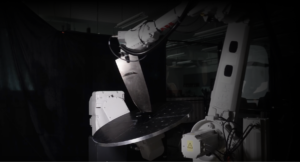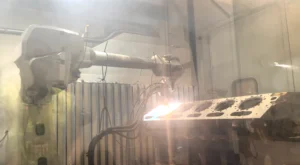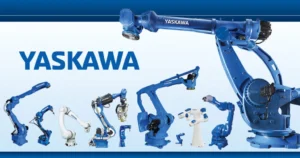table of contents
- Heading 1
- Heading 1
- Heading 1
share this
In the ever-evolving landscape of industrial manufacturing, safety has emerged as a paramount concern. With the introduction of cutting-edge technologies, the movement to increase workplace safety has made great headway. Robotic integration into shot peening situations is one such ground-breaking remedy, providing a safer and more effective substitute for conventional techniques. This article explores how no-coding robots are transforming shot peening workplace conditions, solving issues including the labor shortages, the difficulty of programming robots, and the problem of monitoring and quality control.
Problems

Manual Shot Peening
A Hazardous Environment and a Shortage of Workers
Shot peening is a process vital to strengthening metal components. This process involves the striking of metal components with small spherical particles to induce compressive residual stresses. While this technique enhances the durability of the parts, it necessitates a hazardous work environment due to the potential for exposure to flying particles and noise. Moreover, finding skilled workers willing to perform these tasks has become increasingly challenging, leading to a potential safety compromise. Manual shot peening is also a labor-intensive process that requires skilled personnel to perform the task. This can lead to increased production time, higher labor costs, and the potential for human error.
Monitoring and Quality Control
Consistent monitoring and quality control are required during the shot peening process in order to maintain consistent quality and adhere to strict industry standards. Regular inspection, the measurement of residual stresses and the confirmation of the intended surface hardness improvements can be all part of this.
To ensure proper monitoring and quality control, extra labor hours and technical expertise are required.
The Complex Robot Programming
While the concept of introducing robots to shot peening environments is enticing, the complexity of robot programming has often been a stumbling block. Traditionally, programming robots required extensive coding knowledge and technical expertise, deterring many manufacturers from embracing this innovation fully.
Solution
Robots to the Rescue: A Safe and Effective Alternative
Enter the realm of robotics—a dynamic solution that is revolutionizing the shot peening landscape. Factories worldwide are recognizing the potential of robots to automate this process, eliminating the need for human intervention in hazardous conditions. The use of robots not only mitigates safety risks but also ensures consistent and precise peening, resulting in improved product quality.
No-Coding Robots to the Rescue
No-coding robots are made to be simple to use and require little technical expertise to function properly. Even non-technical staff can set up and handle robot tasks since these robots can be programmed using simple graphical interfaces. This translates to more accessibility and less reliance on highly specialized programming abilities in the context of shot peening.
Users can easily customize their robots to carry out particular jobs with no-code solutions. No-code solutions make the implementation of robotic automation simpler than ever before because there’s no need to search through code libraries or attempt to learn difficult coding languages! You can get the same effects without investing many hours on learning how to write code.
Experience the Future of Shot Peening Automation with Augmentus!
Are you sick of the challenges and complications associated with the deployment of traditional robots for shot peening? Look nowhere else! Augmentus is here to revolutionize the way you approach robotics with its state-of-the-art graphical robot motion planning interface.
Those times of technical training and coding proficiency are over. Even without prior technological knowledge, anyone can easily control and program robots with Augmentus. Our goal is to increase workplace security, improve shot peening procedures, and lessen risk exposure to employees.
Conclusion
The use of no-coding robots in the shot peening procedure constitutes a big step towards raising workplace safety. These robots handle the labor shortage, solve the coding problem, and offer an efficient solution for hazardous environments.



